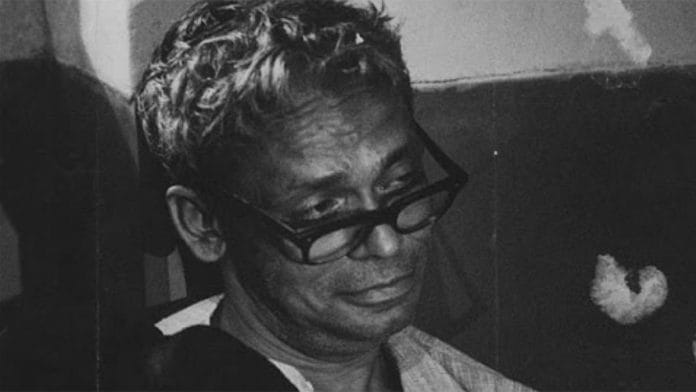Revolutionary filmmaker Ritwik Ghatak mirrored the pain of Bengal’s partition and refugee crisis through his famed trilogy, which began with Megha Dhaka Tara.
New Delhi: Numerous filmmakers have moulded Indian cinema over the years, with some attaining international glory, while others suffered abomination from political circles for daring to tell stories that mirrored the injustices by society and governments.
Nowhere was this clearer than in Bengali cinema, where Satyajit Ray represented the first category, while the second had its torchbearer in Ritwik Ghatak.
Often credited with kick-starting the parallel cinema movement in India, Ghatak rolled out riveting stories of the Bengal partition, of which he was himself a victim. On his 93rd birth anniversary, ThePrint remembers the fierce spirit of Bengali cinema.
Also read: How to torture a bahu: My mom’s very real struggle without Bengali TV serials
A pioneering talent
Ghatak was born on 4 November 1925 in Dhaka, and breathed his last in February 1976 at the SSKM Hospital in what was then Calcutta at the age of 50.
He wore multiple hats — actor, writer, playwright, producer and director. However, unlike artists who worship their mediums, Ghatak always emphasised that as a director, he did not love cinema; he loved the crowd that went to watch the cinema. He even said he was ready to opt for any medium that had the mass appeal of cinema.
This is perhaps why he was able to flit with such ease between theatre, writing and filmmaking.
“I do not believe in ‘entertainment’, as they say it, or slogan-mongering. Rather, I believe in thinking deeply of the universe, the world at large, the international situation, my country, and finally, my own people,” he wrote in his essay, My Coming Into Films.
Ghatak established a reputation as an anti-establishment director with a plethora of movies where he explored complex human reactions to political goings-on.
Nagarik, a commentary on post-colonial India through the eyes of a fresh graduate in search of a job, was reportedly completed in 1952 but was released only in 1977, a year after Ghatak’s death. Many believe this film predates Ray’s Pather Panchali as the first example of an art film in Bengali.
Ghatak directed only eight feature films, belonging to multiple genres, with none being a ‘hit’ at the box office. His second film Ajantrik was the story of a man and his taxi, in which music and sound effects were used to bring the taxi to life.
Ghatak and partition
During the 1960s, Ghatak directed a trilogy which deeply reflected the agony of the partition of Bengal at the grassroots.
Starting with Meghe Dhaka Tara, based on the lives of a ‘bhadralok’ (gentry) Hindu family living in a refugee camp on the outskirts of what was then Calcutta, Ghatak continued his commentary on the political divide with Komal Gandhar and Subarnarekha.
https://www.youtube.com/watch?v=8eugbUixJag
Ghatak weaved his tale around the female leads, etching them in various colours to show the agony of partition and the refugee crisis that ensued. He never celebrated independence through his films, choosing instead to show the cost at which independence arrived.
“It (cinema) is a means of expressing my anger at the sorrows and sufferings of my people,” he once said.
His politics
Ghatak’s narration style was the exact opposite of Ray’s — making the audience uncomfortable. His last film, Jukti Takko Aar Gappo, bore his trademark rebellion, with the director himself playing the lead character of an alcoholic, disillusioned intellectual who comes across the first band of Naxalites in Bengal, though he denied basing it on a political ideology.
“In it, the political backdrop of West Bengal from 1971 to 1972 — as I saw it — has been portrayed. There is no ideology. I saw it from the point of view of not a politician. I am not supposed to please a political ideology,” he said in an interview.
A Communist at heart, he was initially associated with the Indian People’s Theatre Association (IPTA) in 1951, and also briefly taught at the country’s premier filmmaking institute, the Film and Television Institute of India (FTII).
“Now, what is truth? There is no eternal truth. Every artist has to learn private truth though a painful private process. And that is what he has to convey,” he wrote in his book, Cinema and I.
Also read: Cats that wink & science of comets: Sukumar Ray’s fantastic world of literature and creatures
To this day, Ghatak’s works are testament to the social, personal and political turmoil he faced in life. His films and plays bear the stamp of this personal pain, making him a discomfortingly truthful filmmaker.






